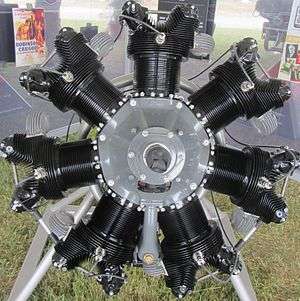Continental R-670
The Continental R-670 (factory designation W670) was a seven-cylinder four-cycle radial aircraft engine produced by Continental displacing 668 cubic inches (11 litres) and a dry weight of 465 lb (211 kg). Horsepower varied from 210 to 240 at 2,200 rpm. The engine was the successor to Continental's first radial engine, the 170 hp Continental A-70. This engine was used on many aircraft in the 1930s and 1940s. The R-670 was widely used in the PT-17 Stearman primary training aircraft of the U.S. military.[1]
| R-670 | |
|---|---|
 | |
| Continental W670 on display | |
| Type | Piston aircraft engine |
| Manufacturer | Continental Motors |
| First run | 1934 |
| Major applications | PT-17 Stearman M3 Stuart |
In addition to being used in aircraft, the R-670 was used in a number of light armored vehicles of World War II.
Variants
Data from: Jane's All the World's Aircraft 1938[2] Variants of the W670 included:
- W670-K
- carburetor, 5.4:1 compression, 65 Octane, front exhausts and 225 hp (168 kW)
- W670-L
- carburetor, 5.4:1 compression, 73 Octane, rear exhausts and 225 hp (168 kW)
- W670-M
- carburetor, 6.1:1 compression, 80 Octane, front exhausts and 240 hp (179 kW)
- W670-N
- carburetor, 6.1:1 compression, 80 Octane, rear exhausts and 240 hp (179 kW)
- W670-K1
- fuel injection, 5.4:1 compression, 73 Octane, front exhausts and 230 hp (172 kW)
- W670-L1
- fuel injection, 5.4:1 compression, 73 Octane, rear exhausts and 230 hp (172 kW)
- W670-M1
- fuel injection, 6.1:1 compression, 80 Octane, front exhausts and 250 hp (186 kW)
- W670-N1
- fuel injection, 6.1:1 compression, 80 Octane, rear exhausts and 250 hp (186 kW)
Applications
Aircraft
- American Airmotive NA-75
- Boeing-Stearman Model 75 (PT-17, N2S)
- CallAir Model A
- Cessna 190
- Eagle Aircraft Eagle 220
- Fairchild PT-23
- Funk F-23
- G class blimp
- Grumman G-164 Ag Cat
- Kellett K-2A, K-4
- Morane-Saulnier MS.317
- Timm N2T Tutor
- Waco 240-A
- Waco Standard Cabin series (UEC, UIC, UKC, UKC-S, UKS, VKS)
- Waco Custom Cabin series (UOC, VQC)
- Waco A series (UBA, ULA)
- Waco F series (UBF, UMF, UPF)
Armored fighting vehicles
- T2 Combat Car
- T4 Combat Car
- M1 Combat Car
- M2 Light Tank
- M3 Stuart
- Landing Vehicle Tracked (LVT-2, -4; LVT(A)-1, -2, -4, -5)
Specifications (R-670-K)
An R-670 fitted to a Boeing Stearman at the Imperial War Museum Duxford
Data from Jane's 1938[2]
General characteristics
- Type: Seven cylinder air-cooled radial
- Bore: 5 1⁄8 in (130.2 mm)
- Stroke: 4 5⁄8 in (117.5 mm)
- Displacement: 668 cu in (10.95 l)
- Length: 34 3⁄16 in (868.4 mm)
- Diameter: 42 1⁄2 in (1,079.5 mm)
- Dry weight: 450 lb (204.1 kg)
Components
- Valvetrain: 1 inlet and 1 exhaust valve per cylinder
- Fuel system: 1 Stromberg NA-R6 Carburetor
- Fuel type: 65 octane
- Oil system: Dry sump, one pressure pump, one scavenge pump, enclosed valve-train
- Cooling system: Air-cooled
Performance
- Power output: 225 hp (168 kW) at 2,175 rpm
- Specific power: 0.337 hp/in³
- Compression ratio: 5.4:1
- Fuel consumption: 13 US Gal/hr (49 l/hr) at cruising rpm
- Specific fuel consumption: 0.54 lb/hp/hr (0.328 kg/kW/hr) - at rated rpm
- Oil consumption: 0.4 US Gal/hr (1.5 l/hr) at cruising rpm
- Power-to-weight ratio: 0.49 hp/lb at cruising rpm
gollark: <@319753218592866315> Fix it.]
gollark: ÆÆÆÆÆÆÆÆÆÆÆÆÆÆÆÆÆÆÆÆÆÆÆÆÆÆAAAAAAAAAAAAAAAAAAAAAa macron.
gollark: ++remind 1h test
gollark: ++data set_global tz Pacific/Chatham
gollark: --remind 1h test
References
Notes
- Gunston 1989, p.42.
- Jane's All the World's Aircraft 1938. London: Sampson, Low & Martin company Limited. 1938.
Bibliography
- Gunston, Bill. World Encyclopaedia of Aero Engines. Cambridge, England. Patrick Stephens Limited, 1989. ISBN 1-85260-163-9
- Jane's Fighting Aircraft of World War II. London. Studio Editions Ltd, 1998. ISBN 0-517-67964-7
- Jane's All the World's Aircraft 1938. London: Sampson, Low & Martin company Limited. 1938.
External links
| Wikimedia Commons has media related to Continental R-670. |
This article is issued from Wikipedia. The text is licensed under Creative Commons - Attribution - Sharealike. Additional terms may apply for the media files.